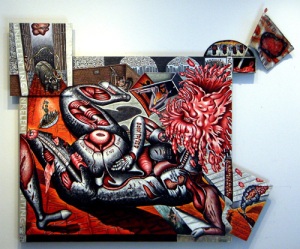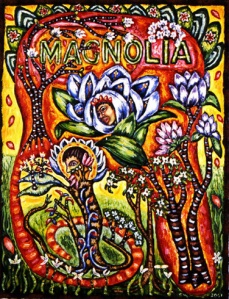
Warbell (from the POISONED WORLD series), mixed media on wood, 47″ x 48″ x 3″, 2006, painting © 2006-2009 by Cathy Wysocki. All rights reserved.
Cathy Wysocki’s pieces fill the main gallery of the Harwood Art Center in Albuquerque. Gripped: Excerpts from Poisoned World does exactly that. The works of art, many three-dimensional, come at you from the walls, grip you by the shoulders and shake you out of whatever state you might be. They collectively caution you to never deny nor forget Suffering in the world today.
Cathy Wysocki paints discomfort and dark worlds, twisted and refigured. Like a visionary chronicler of the times, her expressionistic and surrealist imagery is dramatic & disturbing, conveying a beauty in the horror portrayed.
~Spring/Summer 2009, volume 14, issue 1/2, Harwood Art Center
Struck by the raw power and originality of her work, we were curious to know more about Cathy. Who is she, what has been her journey as an artist, and what moves her to produce the art that she does? We sent Cathy a list of our most pressing questions, and she wrote back with answers.
Nineteen Questions with Cathy Wysocki
Q. How long have you been painting?
A. I have been painting — doing mixed media work — for 30 years.
Q. How has your work evolved over time?
A. I think my work has evolved over time through my expanded use of media and text within my paintings and the growing complexity of the imagery, but more importantly, I have gone from a more personal mythology, let’s say a micro-cosmos, to a more universal, world view, a socio-political macro-cosmos.
Q. Who are your influences?
A. Living in the world is THE influence. But if you want to know who…key influences…I’d say foremost would be the Buddha because of how the teachings have illuminated my path in the world. Then I would say my husband and friend for 29 years, Wayne Hopkins, who is an incredible painter and printmaker — dedicated and always pushing the edge. He has been an enormous supporter of my work/vision. Also, my brother, Michael, had a very strong influence on me during my high school and college years, introducing me to a bigger world and a way to freedom for my creativity and ideas, setting me on my path.
Q. What living artists do you most admire?
A. Sue Coe, Louise Bourgeois, Neo Rauch, Anselm Kiefer, Thomas Hirschhorn, Lee Bontecou. Unfortunately, there are many more dead artists that I admire/connect with, such as Edward Kienholz, Leon Golub, Jörg Immendorf, Francis Bacon, Philip Guston, George Grosz, Otto Dix…well…all the German Expressionists, the Surrealists, and Art Brut artists: Adolf Wölfli, Martín Ramírez, and Carlo Zinelli, to name but a few!
Q. Describe a typical day.
A. An ideal typical day is waking up at 5 a.m. to read a Buddhist text while I drink a cup of decaf coffee. Then practicing sitting meditation for 50-60 minutes. After which I walk my dog for 45 minutes, come home get the caffeine brewing, get the music pumped up, and start working — stopping later to put on more coffee, have toast/breakfast, then back to work until about 3pm. I am much more productive in the earlier part of the day.



From the POISONED WORLD series, El Bruto, mixed media on wood, 59″ x 72″ x 8″, 2009, Unrelenting, mixed media on wood, 61″ x 72″ x 3″, 2009, and Enough, mixed media on wood, 50″ x 63″ x 7″, 2008/2009, paintings © 2008-2009 by Cathy Wysocki. All rights reserved.
Q. What drives your art?
A. Initially, my art is driven by my intuition and imagination, but that is factored into living as a sentient being in a world of suffering.
Q. What messages are in your art?
A. Currently, my series of work is called POISONED WORLD and it is about the three poisons in the world referred to in Buddhism — greed, hatred, and ignorance — and from them the consequences that abound and devastate. It is my hope that my work can bring a startled awareness to such issues as war, shameless consumption and waste, complacency, self-absorption, and to inspire reflection, compassion, and action.
Q. Who are your favorite writers?
A. Right now I am reading 2666 by Roberto Bolaño and I think his writing is unbelievably great. Idiosyncratic, insightful, dense, sharp, witty, dark — all characteristics I love in a writer. Other favorites are Franz Kafka, Thomas Bernhard, Kurt Vonnegut, Gogol, Dostoyevsky, Flannery O’Connor, Kenzaburō Ōe, and Ajahn Chah and Ajahn Buddhadasa for Buddhist writings.
Q. Favorite foods?
A. All things vegetarian.


From the FLOWERS, ROYALTY, THE COSMOS, & MORE series, Count Rade and Princess Ula, mixed media on canvas, 24″ x 18″, 2002, and Magnolia, mixed media on canvas, 18″ x 14″, 2001, paintings © 2001-2009 by Cathy Wysocki. All rights reserved.
Q. Where do you go for inspiration?
A. That depends on the series I am working on. As for the current series, POISONED WORLD, my inspirations are found in observing the consumer culture around me, the devastation of our planet, and the sadness, anger, conflict, and injustice in our society. To compound and intensify that inspiration I read books and articles, as well as watch documentaries on such topics as corruption and corporations; the former Bush Administration; the Iraq and Afghanistan wars; genetic engineering and food; human, animal, and water rights. Music is also a big inspiration — Tom Waits, Bob Dylan, Perfect Circle, John Lennon, Leonard Cohen, The Kronos Quartet, Messiaen’s Quartet For The End of Time. So I guess you could say my work is the bare bulb shining the light within the depths of the darkness.
Q. You’ve been told your work has an “Outsider” quality. Do you consider yourself an Outsider artist?
A. I would say I am a self-taught artist. The art classes I took in college were free-form, I didn’t have any technical training in painting, drawing or sculpture, and I just followed my own vision, did my own thing in my own style, often obsessively. I was not, and am not now, concerned with art trends or commercial viability.
Q. Do you feel inside or outside the art scene (New York City, San Francisco, etc.) and does it matter where you are relative to that scene?
A. I definitely feel outside the art scene here in New Mexico. It does matter because I would like to get the work out there — to broader audiences, more responses, more dialogue — which could be New York, Los Angeles, Mexico City, Berlin. Who knows where my audience is?!


From the CORPARBOREAL series, Corparboreal 26, mixed media on wood, 14″ x 9″, 1999, and Corparboreal 16, mixed media on canvas, 36″ x 32″, 1998/1999, paintings © 1998-2009 by Cathy Wysocki. All rights reserved.
Q. What are the pluses and minuses of living the artist’s life?
A. The plus of living an artist’s life is the freedom to create and express your visions. That plus is so huge it is plural! As for a minus: having to generate an income!
Q. What is your favorite city?
A. I don’t think I have a favorite city. I loved San Francisco when I lived there many years back and I love New York City for all it has to offer culturally. Vienna also left a very strong impression on me as well. I need to travel more!!
Q. If you could live anywhere, where would you choose and why?
A. I don’t have a specific place at the moment, I am in search of it, but I do know there would be an ocean or sea nearby, lots of art museums and galleries, and some great vegetarian restaurants and cafes!
Q. How old were you when you knew you wanted to be an artist?
A. Early on, around the age of four, I had a very rich internal world — active imagination in thoughts and words. However, up through junior high school I didn’t really express myself visually; it was in words and speech. In high school I found the freedom, invention, and originality in visual expression. It became a necessity.
Q. Did your family support your chosen vocation, and if so (or not) how did that affect your path?
A. No, they did not support me being an artist. Perhaps that gave me a stronger drive, subconsciously seeking their approval or support? Regardless, I knew what I was meant to do. Doing something else for their sake would be a false life.


From the BIRTH, DEATH, & REBIRTH series, Coming or Going, What’s the Difference, oil on wood, 48″ x 48″, 1991, and Altitude Without Dimension, oil on paper, 44″ x 30″, 1990, paintings © 1990-2009 by Cathy Wysocki. All rights reserved.
Q. Where do the themes in your work come from?
A. Earlier on I mentioned where my current body of work derives from, but some past series have dealt with such issues as the cycles of birth, death and rebirth inspired by the deaths of both of my parents; a series called CORPARBOREAL, images of tree beings inspired by all the walks with my dogs in the woods of New Hampshire and Massachusetts; and a series of paintings with short tales that I wrote called FLOWERS, ROYALTY, THE COSMOS & MORE. It sprung from finding a collection of old fruit packing labels, and it was about compassion, generosity, right choices. Those are a few examples.
Q. What comes next? Or are you still steeped in the current themes?
A. Yes, I am still currently immersed in the POISONED WORLD — not that there won’t be some toxic offshoots that may metamorphose into another body of work!
 About herself, Cathy writes: I was born and raised in northwest Indiana. With great excitement I departed to the West Coast for college. First to Immaculate Heart College in Los Angeles for a few years, then I transferred to San Francisco State University for a change and to get my BA. My time in California was transformative, clarifying my personal vision and actifying my presence in the world. This was in the late 70’s.
About herself, Cathy writes: I was born and raised in northwest Indiana. With great excitement I departed to the West Coast for college. First to Immaculate Heart College in Los Angeles for a few years, then I transferred to San Francisco State University for a change and to get my BA. My time in California was transformative, clarifying my personal vision and actifying my presence in the world. This was in the late 70’s.
A friend of mine suggested a move to Boston to get studios. Another change. I figured I could always get back to San Francisco. Well, my friend never got there, but I ended up in Boston and the environs from 1980 until 2003, another transformative time, solidifying and strengthening my creative discipline.
In late 2003 I moved to New Mexico. Yet another change in location. New Mexico is fine, but I feel another change in location coming within about 10 years. California?
During my time in San Francisco until the present in New Mexico, I have always worked in my studio and exhibited.
I have had several solo shows, most recently in May, 2009, at the Harwood Art Center in Albuquerque, NM. I have also exhibited extensively in the Northeast and Southwest in group shows at museums and galleries. Recent group shows I have exhibited in: “Mass Consumption,” Mesa Art Center, AA; “Binational,” Museums Of Art in El Paso, TX and Juarez, Mexico; “Cautionary Tales – A Visual Dystopia,” 516 ARTS, Albuquerque, NM; “Originals 2007,” Harwood Art Museum, Taos, NM.
Cathy’s latest show, Gripped: Excerpts from Poisoned World, closes today at the Harwood Art Center in Albuquerque. However, you can keep apprised of Cathy’s works by following her on Flickr.







































